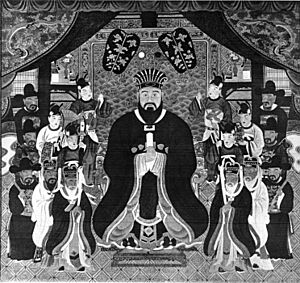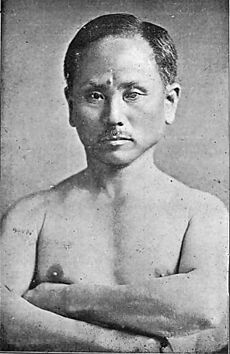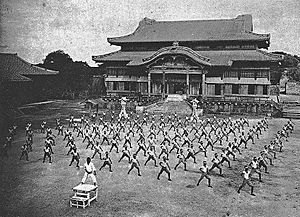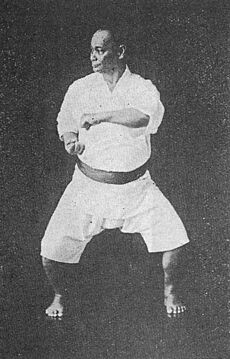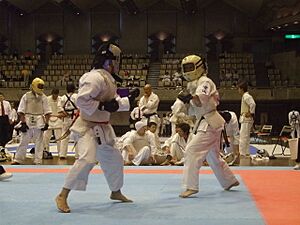Karate facts for kids
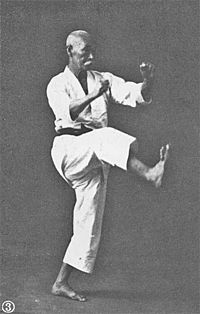
Chōmo Hanashiro, an Okinawan karate master c. 1938
|
|
| Also known as | Karate-do (空手道) |
|---|---|
| Focus | Striking |
| Hardness | Full-contact, semi-contact, light-contact |
| Country of origin | Ryukyu Kingdom (Present day Okinawa prefecture, |
| Parenthood | Indigenous martial arts of Ryukyu Islands, Chinese martial arts |
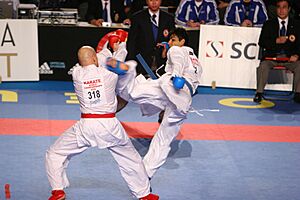
|
|
| Highest governing body | World Karate Federation |
|---|---|
| First developed | Ryukyu Kingdom, ca. 17th century |
| Characteristics | |
| Contact | Yes |
| Mixed-sex | Varies |
| Type | Martial art |
| Presence | |
| Country or region | Worldwide |
| Olympic | 2020 |
| World Games | 1981 – present |
Karate (空手) is a famous martial art that was first developed in the Ryukyu Kingdom, which is now part of Okinawa, Japan. It is mainly a striking art, which means it uses powerful movements like punches, kicks, knee strikes, and elbow strikes. People who practice karate are called karateka.
Karate is more than just fighting. Its full name is Karate-do (空手道), which means "the way of the empty hand." This name shows that the art also teaches important values like discipline, respect, and self-improvement. Today, millions of people around the world practice karate for self-defense, as a sport, or as a way to stay fit and focused.
Contents
What Does "Karate" Mean?
The name "karate" has an interesting history. At first, it was written with characters that meant "Chinese hand" (唐手). This was because the fighting style was heavily influenced by Chinese martial arts that were brought to Okinawa long ago.
In the early 20th century, as the art became more popular in Japan, a master named Gichin Funakoshi helped change the name. He used a different character for "kara" that meant "empty." So, "karate" came to mean "empty hand" (空手). This new name had two meanings:
- It meant that a karateka fights without weapons, using only their "empty" hands and feet.
- It also had a deeper, philosophical meaning about having an "empty" or clear mind, free from anger and fear.
This change helped karate become accepted as a true Japanese martial art.
The Story of Karate
An Okinawan Art of Self-Defense
Karate's story begins centuries ago on the islands of Okinawa. At the time, Okinawa was the center of the independent Ryukyu Kingdom. According to popular stories, the rulers of the kingdom twice banned common people from owning weapons. This was first done by King Shō Shin in the 15th century and later by Japanese samurai who took control of the islands in the 17th century.
Because they couldn't use swords or other weapons to protect themselves, the Okinawans began to develop fighting styles using their bodies. They combined their local martial art, called te (which means "hand"), with fighting styles from China. This mix of styles became the foundation of karate. It was a powerful way for people to defend themselves using only their hands and feet.
Karate Comes to Japan
For a long time, karate was practiced in secret in Okinawa. In the early 1900s, a schoolteacher named Ankō Itosu helped make karate a part of physical education in Okinawan schools. One of his students, Gichin Funakoshi, was key in bringing karate to the rest of Japan.
In 1922, Funakoshi traveled to Tokyo to demonstrate karate. People were very impressed. To help make karate easier to learn and practice, Funakoshi borrowed ideas from another Japanese martial art, judo. He introduced the white uniform, called a karategi, and the colored belt ranking system. These changes helped karate become organized and respected as a modern martial art.
Karate Goes Global
After World War II, many American soldiers were stationed in Okinawa. They learned karate and brought it back home with them. In the 1960s and 1970s, action-packed martial arts movies became very popular around the world. These movies made karate famous, and soon, training halls called dōjōs opened in countries everywhere.
The Three Parts of Karate Training
Karate training is usually broken down into three main parts: kihon, kata, and kumite.
Kihon (Basics)
Kihon means "basics." This is where every karate student begins. It involves practicing the core movements of karate over and over again. These include:
- Stances: How to stand in a strong, balanced way.
- Punches: Different ways to strike with the fist.
- Blocks: How to defend against an attack.
- Kicks: Various ways to strike with the feet.
By practicing kihon, students build a strong foundation for all the other parts of karate.
Kata (Forms)
Kata means "form." A kata is a series of memorized movements—like a choreographed dance—where you fight against imaginary opponents. Each kata includes a specific sequence of punches, kicks, blocks, and stances.
Kata are very important in karate. They teach students how to combine different techniques smoothly and powerfully. They also help improve balance, coordination, and focus. Each kata has a name, and students must learn specific kata to advance to higher belt ranks.
Kumite (Sparring)
Kumite means "meeting of hands," and it is the part of karate where you practice with a partner. This is often called sparring. Kumite helps students learn how to apply their techniques in a real situation. It teaches timing, distance, and strategy.
There are different types of kumite. Some are pre-arranged, where students practice specific attack and defense drills. Others, like free sparring, are more like a real match, where students can use any technique they've learned. In most dōjōs and competitions, kumite has strict rules to make sure everyone stays safe.
The Way of Karate: More Than Fighting
Karate is not just about physical skill. It is also a dō, or a "way of life." This means it teaches important lessons for life outside the dōjō. Many training halls follow a set of rules called the Dōjō Kun. While the exact words can change, they often focus on ideas like:
- Seek perfection of character.
- Be faithful.
- Endeavor to excel.
- Respect others.
- Refrain from violent behavior.
These principles teach students to be humble, respectful, and disciplined. The goal of karate is to build a strong spirit, not just a strong body.
Earning Your Belts
Like many martial arts, karate uses a system of colored belts to show a student's rank and experience. This system was inspired by judo. Beginners start at the lowest rank, usually a white belt. As they train and pass tests, they move up through a series of colored belts.
The ranks are divided into two levels:
- Kyū grades are for beginners. These are the colored belts, such as yellow, orange, green, blue, and brown. Students start at a high kyū number (like 10th kyū) and work their way down to 1st kyū.
- Dan grades are for advanced students who have reached the black belt level. The first level of black belt is 1st dan (shodan). Masters can continue to earn higher dan ranks throughout their lives.
Earning a black belt is a major achievement, but in karate, it is seen as the real beginning of the journey, not the end.
Karate in Competition
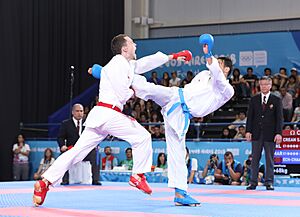
Karate is also a popular international sport. The World Karate Federation (WKF) is the main organization for sport karate and is recognized by the International Olympic Committee.
Karate competitions are usually divided into two events:
- Kata competition: Competitors perform a kata alone on the mat. A panel of judges scores them on their power, speed, balance, and correct technique.
- Kumite competition: Two competitors face each other in a sparring match. They score points by landing clean, controlled punches and kicks on their opponent. Matches have strict rules about which areas can be targeted and how much contact is allowed.
An Olympic Sport
Karate made its first and only appearance as an Olympic sport at the 2020 Summer Olympics in Tokyo, Japan. This was a huge moment for the sport, as the best karateka from around the world got to compete on the biggest stage. Athletes competed in both kata and kumite events.
Different Styles of Karate
Over the years, different masters developed their own ways of teaching karate. This led to the creation of many different styles. While they all share the same basic principles, each style has its own unique focus, kata, and fighting strategies.
Some of the most popular styles of karate in the world today include:
- Shotokan: Known for its powerful, long-range techniques and deep stances.
- Gōjū-ryū: Combines hard, linear attacks with soft, circular movements and focuses on breathing techniques.
- Wadō-ryū: Blends karate with elements of Japanese jujutsu, emphasizing body movement and evasion.
- Shitō-ryū: A style that has a very large number of kata, combining features from different Okinawan traditions.
Even with so many styles, all karateka share a common history and a passion for this powerful and respected martial art.
Images for kids
-
Karate in Naha before the war (before 1946)
-
Karatekas at a dojo with different colored belts
-
Karate movements in Lappeenranta
See also
 In Spanish: Karate para niños
In Spanish: Karate para niños


